For the first time ever, welcome to Bell’s Mailbag!
This inaugural edition will be all about the 2020 NHL Draft, which we don’t even have a date set for. But, we do know when the first Draft Lottery will be – that’s right, the first.
Related: 2020 NHL Draft Guide
With rumours swirling that the draft was right around the corner, the NHL then announced that it was going to be pushed for what will likely be months. They also announced that they would hold a two-phase draft lottery. It’s safe to say that there are many questions in the hockey world.
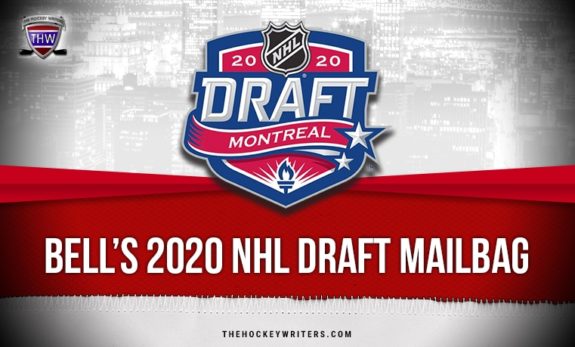
Today, we’ll answer some. On Twitter, I asked for questions about prospects, the draft lottery, or reader’s favourite teams and what they could do in the draft. Here are some of those questions:
“Who do you view as having the lowest risk and highest potential of Tullio, Greig, Vierling, and Finley?”
Question from Curtis on Twitter
Tyler Tullio and Ridly Grieg are both second-round prospects for me, with Evan Vierling and Jack Finley likely third-rounders. Between Tullio and Grieg, in terms of lowest risk and highest potential/reward, it’s Grieg, but not by much.
Related: Ridly Greig – 2020 NHL Draft Prospect Profile
I do think he and Tullio are fairly closer than people think though. Greig is that player who is a fan favourite and other teams hate to play against. He’s similar to a Ryan Kesler or Matthew/Brady Tkachuk in that way. He’s that guy that just knows how to get under opponent’s skin. But at the same time, he brings a great deal of skill to his game. He’s a very good skater who sees the ice well and knows how to slip through defenders.
Tullio is a very, very similar player and has that same mould of a skilled, gritty player. Everything I said about Greig, I could say here for Tullio. I think he’s a very underrated player that a team will likely reach for. The nice thing about Tullio is that his game allows him the adaptability to play in any situation and up-and-down the lineup.
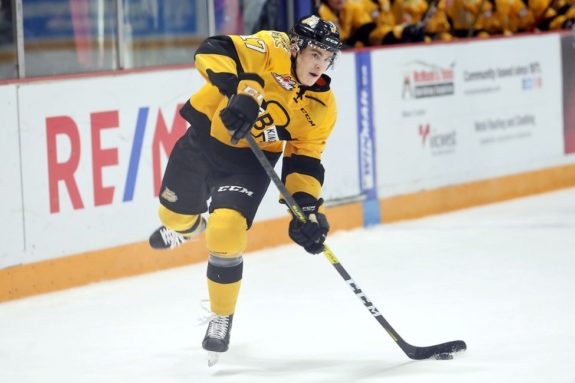
As I said, these two are very close for me and they will be very close in my final rankings. They are both high-compete players, that play hard, fight for pucks, but bring a nice, well-rounded amount of skill to their toolbox. I give a very slight edge to Greig as I think he’s slightly more well-rounded in his game. Even their point totals are close but, Greig played in the more defensive WHL, where Tullio plays in the OHL.
Look for Greig to transition up the hockey ladder a little faster and a little easier than Tullio.
“What makes Jan Myšák such an intriguing pick?”
Question from Mathieu on Twitter
Ah, Jan Myšák. The young Czech player has been a favourite of mine since before the season, firmly being in my top-12 in every edition of my rankings. He will remain one of the players I’m most looking forward to tracking how he progresses.
Related: Jan Myšák – 2020 NHL Draft Prospect Profile
Starting out the season in the Czech Extraliga, Myšák more than held his own. His nine points (five goals, four assists) in 26 games may not sound all that impressive, but what if I told you that that total was the most points from an under-18 player in the league? Playing just half the season there before coming over to the OHL’s Hamilton Bulldogs?
Once he got to Canada, everyone seemed to take notice. He wasted no time, putting up 25 points in 22 games until the season was cancelled. Myšák is a well-rounded, offensive talent. He has a very good shot, and he sees the ice so well that he’s able to find teammates through traffic.

He’s been playing against men since he was 16, so it’s not hard to understand why he’s an extremely confident player. He can be a dominant force on the ice, taking calculated risks when he sees an opportunity. More often than not, they pay off. His skating has been noted as a cause for concern, but from what I’ve seen, he doesn’t have too much to worry about. He doesn’t have one aspect of his skating that stands out as elite or even the best in the class, but his overall package of speed, acceleration, agility, and use of his edges are very good.
We’ll see how he does with a full season in North America (hopefully, depending on COVID-19), but he looks to be a very promising player. In my opinion, this is a high-potential young forward. As a late-June birthday, I think he could be poised for a very big 2020-21 campaign.
“If the Islanders happen to lose the play-in and win the lottery, is their first-round pick still lottery-protected?”
Question from James on Twitter
For some context, at the 2020 NHL Trade Deadline, the New York Islanders traded their 2020 first-round pick to the Ottawa Senators, along with a 2020 second-round pick and a conditional 2022 third-round pick, in exchange for centreman Jean-Gabriel Pageau. That first-round pick carried the condition that if the Islanders were to miss the playoffs and win the Draft lottery (a top-three selection), they’d retain their 2020 pick and their 2021 first-rounder would go to the Senators.
All of the conditional draft picks for the first round of the 2020 NHL draft remain intact. So the Islanders’ first-rounder is still top-three protected. What would you rather Islanders fans? A top-three pick in 2020 or a chance at the Cup?
“What happens to the draft position of teams that win in the play-in & lose in the 1st round?”
Continued: “Say, Montreal makes it to the 1st round and loses its playoff series. Do they go back to #8 or do they go behind the play-in losers?”
Question from Kickabrat on Twitter
If the Montreal Canadiens wins their play-in round against the Pittsburgh Penguins, they are in the playoffs and the regular rules apply. At that time, their eighth-round pick is gone.
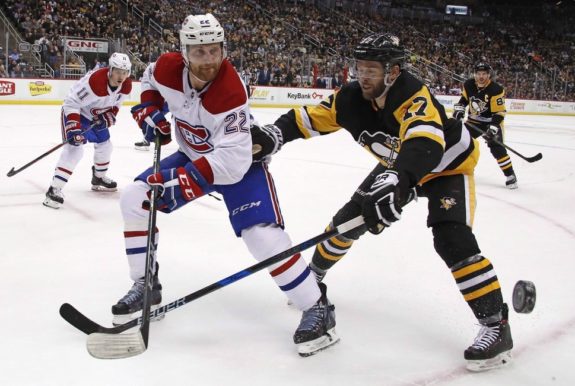
There are 15 teams that have a chance for the top-15 picks in the 2020 NHL Draft. Seven of those spots are locked down by the Detroit Red Wings, Ottawa Senators (twice, thanks to the San Jose Sharks), Los Angeles Kings, Anaheim Ducks, New Jersey Devils, and the Buffalo Sabres. The remaining eight spots will be filled by the losers of the play-in round, based on regular-season points percentage.
Related: NHL Announces 2020 Draft Lottery Format
If the Habs were to beat the Penguins, they are officially in the NHL Playoffs. That would mean that they would pick no higher than 16th in the draft. If they were to lose in Round 1, that’s where they would pick (16th) as they’d have the lowest seed entering the playoffs. The only way to keep that eighth-overall pick is by losing to the Penguins.
What would you rather, Montreal fans? The eighth-overall pick or a chance at Lord Stanley’s Cup? Remember, once you’re in the playoffs, anything can happen.
“I don’t know much about Sean Farrell, what type of player is he?”
Question from Unbeleafable on Twitter
I really like Sean Farrell. The Chicago Steel forward is a playmaker first, but he can score too. His passing game is one of his strongest assets, which is proven by his USHL-leading 41 assists.
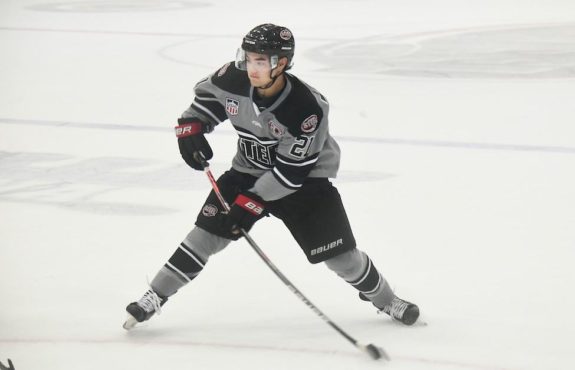
His offensive awareness allows him to find his teammates with ease, but he has the patience and the intelligence to make sure he fires the pass at the right time. As I mentioned though, he can score too. he had 15 goals this season, but at the World Under-19 Hockey Challenge collected five goals in just six games.
Related: Chicago Steel Set to Make an Impact on 2020 NHL Draft
His shot can be very good, but he just doesn’t use it as much as I’d like. He’s very confident in his passing, which is why he tends to have a more pass-first mentality. If he builds confidence in his shot, he could become that much more of a dynamic offensive threat.
While he’s on the smaller side at 5-foot-9, he doesn’t play like that. He’s hungry for the puck, isn’t afraid to battle along the boards, and will fight for positioning in front of the net. Overall, Farrell could be a very good prospect to add to a pool. I think he’ll take some time before really getting a shot at the NHL (He’s also headed to Harvard University in 2020-21), but with some patience and proper development there looks to be a promising player there.
“Who do you like most for the Blue Jackets out of the Zary/Holloway/Mercer/Jarvis/Gunler etc. group?”
Question from CBJ on Twitter
For this question, I reached out to our Columbus Blue Jackets’ expert, Mark Scheig – who just so happens to also be a prospect expert – to get his thoughts. Here’s what Mark had to say:
“The expectation is that Dylan Holloway would likely be gone by the time the Blue Jackets get to the podium. If he’s somehow still available, I’d expect he’d be the pick given his position and upside. As for the other four, I’d rank them Connor Zary, Noel Gunler, Seth Jarvis, Dawson Mercer. Gunler has the most skill but questions about him are legitimate. Zary projects as a top-six center and would fit the mold the Blue Jackets are looking for. The other two Jarvis and Mercer are good players but each have next-level questions.”
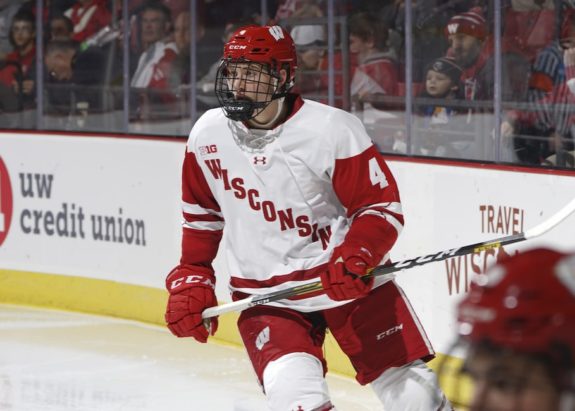
Well, Mark and I agree that Holloway would likely be gone by then. I suspect Jarvis would be gone by then too actually, but he’s a guy that Mark and I have ranked quite differently.
My ranking of these players would likely be:
- Seth Jarvis
- Dylan Holloway
- Noel Gunler
- Connor Zary
- Dawson Mercer
While Mark and I have slightly different rankings, we do agree on one thing: Zary would fit the Blue Jackets system well. The centreman could very well come into the prospect pool as the top prospect and be a future first or second-line centreman. He’s a solid two-way player but brings a very intriguing offensive touch. The team that lands him will be very happy that they did.
Related: Connor Zary – 2020 NHL Draft Prospect Profile
All this being said, the draft order could look very different by the time draft day actually rolls around. Once the order is set, this question might need to be given another look.
“Thoughts on Khusnutdinov? Would he be a good fit the Wild with their second first-rounder?”
Continued: “…especially given their overall lack of depth at center?”
Question from Justin on Twitter
The Minnesota Wild lack a whole lot of skill up front in their system after Kaprill Kaprizov, Matthew Boldy, and Adam Beckman. Adding to that: they are all wingers. The Wild have Alexander Khovanov and Damien Giroux as centremen but really lack in that high-end skill down the middle (you could make an argument that Khovanov is right there though). Marat Khusnutdinov could start to fill that void.
Related: Marat Khusnutdinov – 2020 NHL Draft Prospect Profile
On top of his high skill level, Khusnutdinov brings an extremely high compete level to his game. He never takes his foot off the gas pedal. From the prospect profile above, written by me:
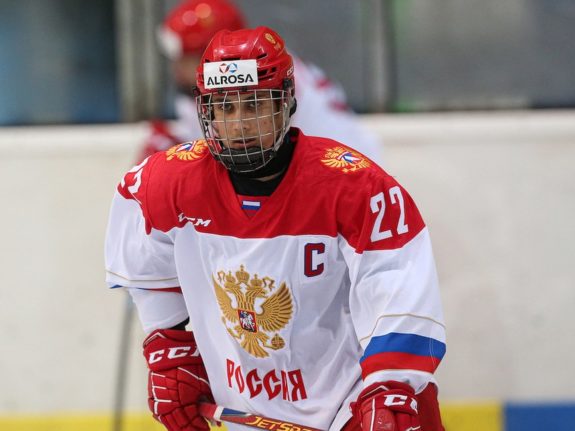
“If he has the puck, he’s aggressive, forcing his way to the net or to an open spot. Without the puck, he’s on a mission to get it back. He plays hard at both ends, blocking pucks, and his forechecking might be among the best in this class… He has a good top speed and excellent edges as well, making him very dangerous…
“Khusnutdinov has incredible vision and hockey sense, able to find his teammates across the offensive zone for an assist or drive to the net for a slick goal. He’s got an incredible shot which he can fire quickly, beating goaltenders before they know the shot’s off.”
With the Wild’s second first rounder, the young star could be and should very much be on their radar.
“Why the disparity on Foerster?”
Continued: “Some like him to be a top-25 pick while others see him as a mid-late second-round pick.”
Question from Justin on Twitter
For this one, I reached out to fellow THW draft writer Larry Fisher. In his May draft rankings, Tyson Foerster came in at 40th. In my final ranking, he’ll likely come in at the 20-25 range. So we have a little bit of that disparity mentioned. We’ll start with Larry’s answer:
Related: Tyson Foerster – 2020 NHL Draft Prospect Profile
“Foerster’s skating is the concern for some. It reminds me of the skepticism surrounding Nolan Foote last year, with many ranking Foote outside the top 50. Most didn’t like Foote as a first-rounder because his skating had been labelled as “bad”. Foerster is getting the same “bad” rap from many of the same critics, but I prefer to focus on his strengths, which are also much the same as Foote — possessing an NHL-calibre shot with a wicked release. It is hard, it is accurate, and Foerster enjoys being the triggerman as a shoot-first forward.
Fisher continues, “But Foerster showed down the stretch that he can drive play and generate offence for himself and his linemates as the go-to guy in Barrie, which is the reason for his rise in the rankings. He also appears to be a better playmaker than Foote. Foerster is one of the best shooters in this draft class and every team needs goals, so I expect him to be taken in the 20-40 range — likely in the back half of the first round, somewhere in the twenties. As for NHL comparables, I look to two Vancouver Canucks wingers — Brock Boeser and Tanner Pearson. Foerster has traits of both and could top out somewhere between them in his prime.”
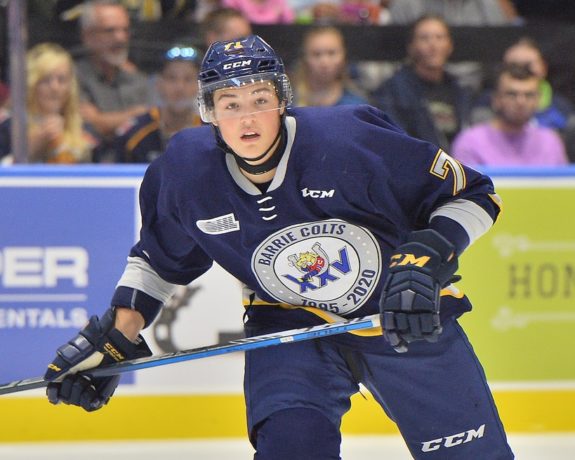
Well, I don’t need to add much to this. Larry hits it right on the head. He mentions how the young Barrie Colts star can drive the play and generate offence for himself and his team. That’s thanks to his high hockey IQ and ability to read the play. There are times where it seems like he’s two steps ahead of everyone on the ice.
I see the concerns, which Larry also points out, about his skating. His top speed isn’t overly fast, and he needs to work on both his first step and acceleration. That’s a red flag to some, but looking at his peak potential, I’m very intrigued by Foerster.
“What do you think about this year’s power forward class? “
Continued: “Is it an exceptional group that could throw off draft boards as teams fall in love with their size, or do you think they will settle into the third-round like they are projected?”
Question from THW’s Eugene Helfrick
This is a very intriguing question, one that I thought I should bring Larry in on as well. The power forward is an interesting player type that isn’t talked about as often when it comes to the NHL Draft. But when it comes to draft day, a lot of the time, these are the guys that teams reach for and surprise. The 2020 NHL Draft could be interesting to watch for that.
Here’s Larry’s answer:
“Indeed, rankings are a different beast from a mock draft — let alone the actual draft. Several teams will reach for size. That infatuation still exists today, mainly because it is still “big boy” hockey come playoff time and winning the Stanley Cup is all that really matters. Looking at my own rankings, I see a lot of power-forward types that will be taken higher than I have them ranked.
“Certainly Dylan Peterson and Will Cuylle, for starters. They didn’t have very productive draft years and fell in most rankings as a result. But come draft time, teams are still going to see that NHL upside in those two and they could go in the top 50 but surely in the top 100 — in the top three rounds. Jack Finley is going to surprise a lot of people with how high he goes — another top-50 candidate as one of the biggest and youngest prospects in this draft class, with NHL bloodlines to boot.

“Jaromir Pytlik is another right-handed centre — like Peterson and Finley — with good size and a strong two-way game that could be taken sooner than later if a team sees offensive upside in his package. On the wings, there is Roby Jarventie from Finland and Daniel Torgersson from Sweden as top-50 candidates. Luke Tuch, the younger brother of Vegas Golden Knights’ winger and first-rounder Alex Tuch, is also in that mix.
“Brandon Coe is another big winger who had a good season on a bad team, flying a bit under the radar despite impressing in the CHL Top Prospects Game. He turned heads in that showcase and could be a second-rounder as a result. Fellow OHLer James Hardie, William Dufour from the QMJHL and Carson Bantle from the USHL could also become second-round reaches based on their upside as power forwards, but that trio should be taken somewhere in the top four rounds — with the potential for all three to go in the top 100.
“Egor Sokolov is a beast as one of the best overagers this year — this is his final year of eligibility after twice being passed over in 2018 and 2019 — and his World Junior performance should ensure a top-100 selection, though it wouldn’t be shocking if he went much higher and perhaps even in the top 50. Maxim Groshev is another Russian power forward that could crack the top 100.
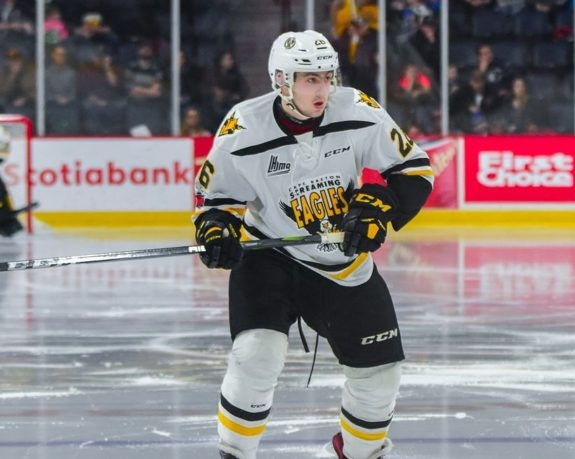
“I’m admittedly cautious when it comes to ranking high-schoolers, but a couple that come to mind with nice big frames are Lucas Mercuri and Riley Duran. I don’t know if they will be taken in the top 100, but I could see teams taking a liking to those two as draft-and-develop projects based on their size and upside.
“So, to answer your question — yes, size will still have a factor in the draft and those 15 prospects could all go significantly higher than they are ranked.”
Again, I don’t need to add much to this as Larry nailed the answer again. I’m on the same page as him here, I could definitely see some of these players going higher than the scouting community has them now. For many teams, they’re willing to bet on size. It doesn’t always pan out but for many of the players that Larry mentioned, they bring numerous other tools to the table.
One I’ll highlight is Pytlik. He’s fallen on some draft boards, but he’s a guy that I think could really surprise with where he’s taken. He’s still very much a top-50 prospect for me.
Could this be a draft of surprises? I really think it will be. And the power forwards that are available could be very big parts of that.
Thanks for reading the first-ever Bell’s Mailbag! I’ll be looking to do this a few times leading up to the 2020 NHL Draft, and continuing it after as well. If ever you have questions, feel free to reach out @JoshuaBellTHW on Twitter. You can also drop a comment here or in any other article of mine.
Get the latest NHL Draft & Prospect rankings, news and analysis